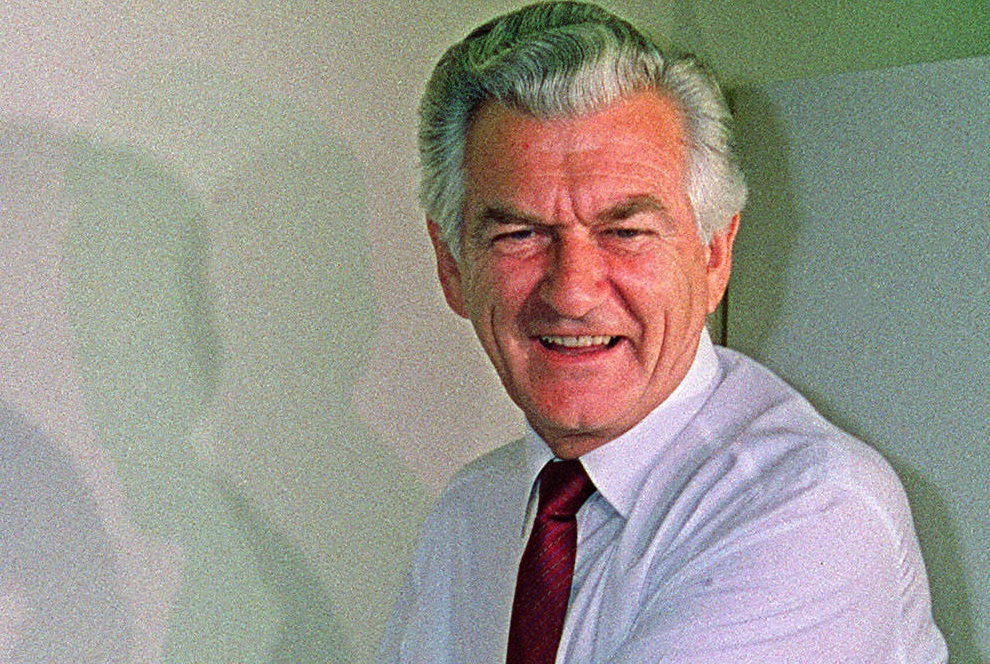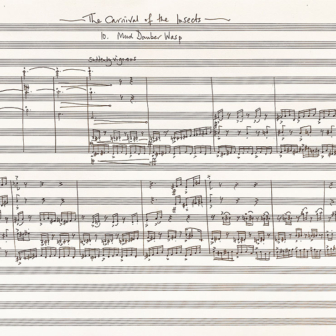In 1986, in the midst of rural revolt, economic crisis and a series of well-publicised industrial conflicts, the media discovered the New Right. Its emergence cannot have had much to do with actual strike activity, since the number of working days lost through industrial disputes had fallen from almost 4.2 million in 1981 to less than 1.3 million five years later. Rather, the New Right’s emergence represented a revolt against the consensus politics of the Hawke government.
Business organisation was fragmented in the mid 1980s – a disunity skilfully fostered by prime minister Bob Hawke almost from the moment he came to office – and there was nothing even approaching a consensus about the best way of organising industrial relations. The New Right focused attention on the damage wrought by excessive government regulation and tariff protection but most of all by union power and the arbitration system. For eighty years, its proponents said, Australia had been penalising its highly efficient export industries – pastoralism, agriculture and mining – to prop up the manufacturing industry and urban wages.
Two articles in the right-wing magazine Quadrant early in the Hawke years crystallised attitudes. The first was by a middle-ranking public servant in the Department of Employment and Industrial Relations, Gerard Henderson, who had earlier been on the staff of Bob Santamaria’s right-wing Catholic National Civic Council. In his September 1983 article, “The Industrial Relations Club,” Henderson presented Australian industrial relations as fundamentally an exercise in mutual back-scratching. A coterie of Melbourne-based commissioners, union leaders, business representatives, industrial lawyers and public servants operated “in a club-like atmosphere” surrounded by “an ethos of complacency and self-congratulation” in which economic realities took second place to deal-making.
A second contribution to Quadrant, a year later, came from Treasury secretary John Stone. Stone had already announced his intention of resigning from the public service when he delivered “1929 and All That” as the Edward Shann Memorial Lecture at the University of Western Australia. Like Henderson, he had the wages system in his sights – “a crime against society” – but Stone developed a more ambitious argument that “the spirit of enterprise is shackled and weighed down by the dead hands of governments.” He appealed to the spirit of achievement represented by Gallipoli, Kokoda, Douglas Mawson, Charles Kingsford Smith, Howard Florey and Geoffrey Blainey.
Stone and Henderson had one thing in common, apart from their right-wing politics. As civil servants, neither had themselves been much subjected to the rigours of the market. Indeed, it was a feature of the New Right revolt that it tended to bring together aspiring politicians, political staffers, speechwriters, academics, public servants, consultants, lawyers, journalists and industrial relations practitioners. People risking their own money were not only inconspicuous, they were frequently berated as part of the problem on account of their cosy deals with government and unions. Yet it was critical to the New Right’s campaign to reshape Australian public policy that conventional ways of thinking about both the resolution of industrial conflict and the public service needed to be discredited. Industrial arbitration had to be stripped of its remaining judicial dignity, the public service of any residual status it enjoyed as a patriotic calling connected with a nation-building project.
Henderson took to this task with relish, opening a 1986 speech by ridiculing the department that had once employed him for the number of refrigerators it provided its staff. His former colleagues, he indicated, were stupid and self-serving, overwhelmingly concerned with their pleasures and perks. At the lunch held to mark his departure from the Department of Employment and Industrial Relations, he “ruefully reflected” that during his four years in the public service he “had lost more brain cells than any of my senior officers were born with.” This comment, he added, “was not appreciated by some senior officers. Some others, fortunately, could not comprehend it.” By the time he made this speech to a group of like-minded right-wing activists, Henderson was exercising what was left of his brain cells as chief of staff to opposition leader John Howard.
These activists drew on a particular understanding of Australian history, a melodrama of “goodies” and “baddies” in which the “baddies” – Alfred Deakin’s early twentieth-century Liberals and the Labor Party – had triumphed over a few economically literate souls who recognised that the laws of supply and demand could not be lightly brushed aside. They reserved a particular venom for Henry Bournes Higgins, the pioneering Arbitration Court president and architect of the living wage. Higgins, in arguing that industries must either pay their workers a living wage or cease to trade, was responsible for the gross inefficiencies that had sent Australia into inexorable national decline. In short, according to leading New Right figure Ray Evans, Higgins was “a nut… who, to the great detriment of his country, found himself able to give legal form and substance to his fantasies.”
The response of those who wished to deal with “our Higgins problem,” as they called it, was to establish the H.R. Nicholls Society in early 1986. Henry Nicholls had been an English radical, a Chartist who came to Australia during the 1850s gold rush. Many decades later in 1911, in his dotage as the editor of a Tasmanian newspaper, Nicholls found himself charged with contempt of court after writing of Higgins as a “political judge.” Ray Evans, who had himself once been a Labor man but was now an assistant to Western Mining’s Hugh Morgan, was impressed by Nicholls’s defiance when he encountered the story. Along with John Stone, Barrie Purvis, the director of the wool-broking employers’ body, and Peter Costello, a young barrister and Liberal Party activist, Evans wrote to potentially interested parties in January 1986 proposing the formation of a society “to give new impetus for reform of the present labour market and to provide a forum for discussion of alternatives to the present regulation of industrial relations.” The letter suggested that the stakes were high. The outcome of the present debate over industrial relations would have “great significance… for Australia’s future economic growth, political development and ultimately, perhaps, territorial integrity.”
Costello had recently become a figure of some national repute on the back of a legal battle in Victoria. The Dollar Sweets case arose from an industrial campaign run by the Federated Confectioners’ Association. As in other famous industrial cases of the mid 1980s, the situation was peculiar. The union concerned, led by Carlo Frizziero, was militant, hostile to the Hawke government’s Prices and Incomes Accord with the unions, and on the far left of the Victorian Labor Party. In April 1985, just a few weeks before the Dollar Sweets strike, the small group of left-wing unions with whom Frizziero was associated had suffered a major defeat at the Victorian Labor Party’s annual conference, when they failed to prevent the readmission to the party of four conservative unions that had left during the split of 1955 and subsequently been associated with the Democratic Labor Party: the Clerks, Shop Assistants, Ironworkers, and Carpenters and Joiners.
The party conference damaged the far left’s image, and did little to enhance that of the Victorian Labor Party generally. The wild melee that occurred at the Coburg Town Hall recalled the physical combat and bitter passion of the episode to which this Sunday morning was a tragicomic postscript: the Labor split of 1955. It was one thing to issue black armbands to delegates entering the hall, and for the president of the Musicians’ Union to play on his clarinet “a mournful refrain of The Last Post.” It was quite another for left-wing activists to hurl abuse, punch and jostle delegates, and throw overripe tomatoes at their opponents as they tried to enter the hall.
The Dollar Sweets dispute added to the reputational damage incurred by the far left unions. A small family business with twenty-seven employees operating in suburban Glen Iris, Dollar Sweets was well-suited to an anti-union propaganda blitz. Here was another case of “the little man who stood up to trade union bullies and thugs.” The boss, of Austrian descent, was Fred Stauder, and among the firm’s products were Hundreds and Thousands, as seen and admired on fairy bread and birthday cakes at children’s parties. The confectioners’ union, having achieved a reduction of working hours to thirty-six per week in the larger firms, had now moved on to the likes of Dollar Sweets. But Stauder replied that the business could not afford any additional reduction in the working week. In July 1985 the union called a strike and established a picket; fifteen of the company’s employees stopped work. After Stauder told them that they would either have to sign a no-strike agreement or face dismissal, he terminated their employment and replaced them.
The strike was not good-humoured. Telephone wires were cut and locks filled with glue. There was a bomb threat, an arson attempt and a physical altercation between Frizziero and a truck driver delivering sugar to the factory. The union dropped its claim for reduced hours, but demanded that the striking workers be reinstated. Stauder turned to senior business leaders for help. They directed him to Peter Costello, a twenty-eight-year-old barrister, who offered as a long shot the possibility of a successful common-law tort action. With the Melbourne Chamber of Commerce providing the money, Dollar Sweets issued legal proceedings against the union. The following month, a decision of the Supreme Court called the union’s behaviour “stupid and nihilistic” and ordered that the picket be lifted. The parties later settled for a union payment of $175,000 in damages.
A much bigger strike during 1985 also helped place a spring in the step of New Right activists. The dispute occurred over the efforts of the South East Queensland Electricity Board, or SEQEB, to use contract labour. The National Party government had introduced a regime of equalising electricity costs across the state, the effect of which was to impose a large cross-subsidy of rural and provincial consumers at the expense of those living in the major centres. But the result – massively increased electricity prices for city-dwellers – was potentially damaging to the government at a time when Bjelke-Petersen’s decision to sever his coalition with the Liberal Party demanded National Party electoral gains in the more populated areas.
The dispute bubbled on for almost a year before exploding into a full-scale strike in February 1985. Efforts by the State Industrial Commission to settle the dispute were unavailing and on 7 February, with thousands of consumers already in the dark, the Bjelke-Petersen government declared a state of emergency. With the government’s support, SEQEB management subsequently sacked 1000 striking linesmen, replacing them with non-unionists bound by contracts containing no-strike clauses.
Solidarity strikes, pickets and protest marches were ineffective in countering Bjelke-Petersen’s war against the union’s members. Instead, the government introduced a series of laws intended to curb union power in the industry. And in a move that reprised his ban on street marches in the late 1970s, Bjelke-Petersen transformed protest into a threat to law and order by strengthening the powers of police in a manner that outlawed pickets. Anyone now deemed to be interfering with the power supply could be arrested. In August a handful of members of a group that called itself “Concerned Christians” protesting near SEQEB headquarters were arrested under the Electricity (Continuity of Supply) Act.
Most of the striking workers were left without jobs or hope but with a burning resentment of their treatment at the hands of SEQEB, the government, union officials and timid Labor politicians. Many thought they had been sold out by their leaders for the sake of career advancement and political advantage. There was particular bitterness over the abject surrender of the Trades and Labour Council. Meanwhile the strike’s undoubted victor, Bjelke-Petersen, reached his apogee as a hero of the political right.
The growing aggression of a handful of employers in the mid 1980s saw a distinct reaction set in, based on the suspicion that industrial warfare incurred intangible social and economic costs along with the more obvious benefit of being able to pose, like an ancient ruler, with one’s foot firmly planted on the neck of a vanquished foe. The tipping point was Robe River, the last of the fabled New Right industrial disputes of the mid 1980s, and the most ambiguous in its immediate politics and eventual impact. No dispute better illustrates the New Right’s apocalyptic vision of how a period of intense conflict would give way to an industrial utopia in which bosses and workers would deal with one another as autonomous and rational individuals, free from the insidious interference of union or state.
Robe River was in the Pilbara, a remote region in the northwest of Western Australia that was a leading producer of iron ore. It had operated from 1970 as a joint venture under the management of the American firm Cleveland Cliffs, but in 1986 Peko-Wallsend, one of the partners, became the majority shareholder and took over running the company. Its profitability climbed rapidly in the first half of the 1980s. But the Japanese steel industry, which was Peko’s leading customer, entered a more difficult period after 1985, which reduced the scope for exports. Peko’s new chief executive, Charles Copeman, blamed the company’s problems on slack management and “restrictive work practices” – a phrase that entered the political lexicon at this juncture. After sending in a team of executives to investigate, Copeman sacked four senior managers and demoted the managing director, then declared existing industrial agreements null and void. Hypocritically – considering Copeman’s contempt for the arbitration system – the company wanted to place all workers on the site under the federal award system, a move opposed by the state Labor government.
To the extent that restrictive work practices were a problem at Robe River, they were the result not of the compulsory arbitration so hated by New Right ideologues but of the local collective bargaining they wanted to replace it with. Robe River had differed from other Pilbara companies in seeking to exploit the spot – or short-term – market in iron ore rather than use long-term contracts. Spot prices were higher, but with this came an acute sensitivity to industrial disruption, which in turn encouraged a compliant response to union demands. For the new management, it seemed that if local arrangements could be overridden, many of the practices that Peko believed were wrecking the operation could be removed.
Having announced its intention to remove restrictive work practices, the company conducted what many workers saw as a reign of terror. It transferred workers around the operation irrespective of previous arrangements, including a sixty-year-old tea lady who was “reclassified as an ore handler and put out on yard duties.” While the company did its best to present its workers as the beneficiaries of a well-developed system of rorts, there was also sufficient adverse publicity about Peko’s behaviour to prevent Copeman from becoming a popular hero.
Peko’s aggression and vindictiveness disturbed even those convinced that conditions at Robe River were on the soft side. Union representatives complained that management had targeted them for demeaning work in what they called “punishment details,” while the company introduced new tenancy agreements in the company towns of the northwest, providing for a 400 per cent rent increase for workers who went out on strike. Wives feared being evicted from their homes while work contracts now provided that “any or all of the conditions of employment can be changed weekly at the sole discretion of the company.” Most seriously for Peko’s reputation, when the WA Industrial Relations Commission ordered a moratorium on industrial action and investigation of work practices, the company sacked sixty-four employees who had resisted changes in their working arrangements. When the commission ordered their reinstatement, Peko sacked its entire workforce of 1160; it looked like the kind of lawlessness of which H.R. Nicholls Society types had accused unions at Dollar Sweets.
In Pilbara towns such as Pannawonica and Wickham, workers and their families were seething at the company’s behaviour. Some were prepared to acknowledge the “rorts” and conceded that there were practices that could readily be abandoned. “I know there’s got to be changes,” commented one worker. “I think most of us do. But the way the company’s going about it. You know, just splitting the town, making people angry.” Pilbara families especially resented the idea, current in the state’s more closely settled south, that they were “filthy rich” and living a life of luxury and comfort. Food, electricity and petrol prices were high, and holidays expensive because of the region’s remoteness.
Central to Peko’s strategy for dealing with its workforce was to sow divisions between the white- and blue-collar employees, between “staffies” and “wages.” Staffies had to sign contracts agreeing to take the places of striking blue-collar workers or face dismissal. Previously, community clubs and organisations – indeed, the Pilbara towns’ social life – had revolved around easy sociability between the two groups. As blue-collar workers and their families saw it, there was little consciousness of status difference between them: it was “a close-knit community” in which people “got on well.” Hence, for blue-collar unionists, the failure of most clerical staff to support them aroused bitter resentment; they regarded them as “scabs” and shunned them. Those who turned up to take the places of striking workers were greeted at the security gate by a menacing banner that proclaimed: “Scabs. Nowhere to run. Nowhere to hide.” Staff who entered a local hotel “soon left under a barrage of abuse from unionists.”
The lockout ended on 3 September after the Industrial Relations Commission rejected Robe River’s appeal against an order to reinstate sacked workers. But the company’s refusal to enter into conciliation meant that there would be no quick end to the dispute. The commission eventually upheld the company’s right to eliminate restrictive work practices. Union leaders had worked hard to restrain their members, preferring “passive resistance” to a strike. But the company continued to carry out reprisals. In December 1986 a strike finally occurred over harassment of unionists, white-collar workers performing blue-collar labour, and staffing levels. Pickets were established and unionists showered abuse on strike-breakers as they arrived for work each day. Meanwhile, the company took its cue from Dollar Sweets – Peter Costello was advising Copeman – and issued writs against individual union officials and conveners.
In the New Right industrial fable, Peko was a tower of strength. In reality, there were good reasons why it should now seek a compromise. Peko’s Japanese partners had expressed their concerns about the company’s manner of dealing with its employees as early as August, and the WA government was furious with Peko for the dispute’s impact on the state’s reputation as a reliable exporter of iron ore. Bob Hawke, equally unimpressed, had called employer militants of the Copeman type “political troglodytes and economic lunatics.” The ACTU had established a fighting fund and workers from other Pilbara mines had expressed a willingness to shut down the whole region’s iron-ore operations. Even as it issued one legal writ after another, Peko could not be sure of how far the unions would be prepared to go.
Early in 1987 negotiations between ACTU president Simon Crean and Copeman resulted in a peace deal, although not without some resistance from rank-and-file unionists. It was hard to miss the irony: Copeman, the scourge of arbitration and the unions, had relied on one to deal with restrictive work practices, and on the other to extract him from the industrial chaos of his own making.
Peko was soon reporting a happy and productive workforce, which the company and its New Right supporters treated as vindication. Sceptics, however, were unconvinced by claims of an outbreak of happiness, and pointed out that other companies seemed to have managed greater productivity, and probably greater happiness, without prosecuting industrial warfare on a grand scale.
Nor can the federal government’s move away from allowing price inflation to determine the level of the basic wage (a system called “indexation”) late in 1986 be seen as a direct outcome of the New Right revolt. Hawke had been playing with the idea of linking wage levels to considerations of efficiency and productivity, in addition to price increases, for many years, and the government remained committed to an entrenchment of the award system and the role of unions within it. And it is by no means self-evident that it became easier as a result of Robe River, at least in the short term, to imagine large workplaces across the nation full of employees on individual contracts, for the dispute was also an illustration of the costs of open industrial warfare.
Robe River also brought the H.R. Nicholls Society to national attention as a mysterious and possibly dangerous cabal, contributing to New Right stridency – and a backlash against it that would soon have disastrous political consequences for opponents of the Hawke government. The Prices and Incomes Accord was based on a fusion of politics and industrial relations that eventually helped keep the Labor Party in office for longer than any previous national Labor government. But the political right’s attempt at creating its own fusion would help keep the Coalition out of power for another decade. •
This is an edited extract from The Eighties: The Decade That Transformed Australia, by Frank Bongiorno, published this month by Black Inc.




